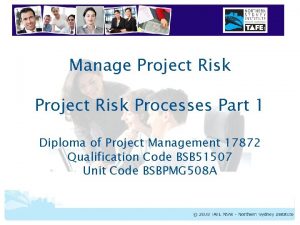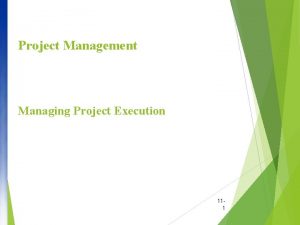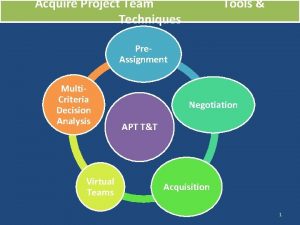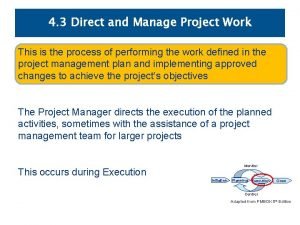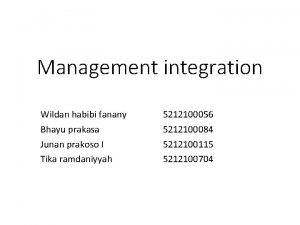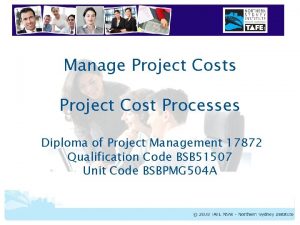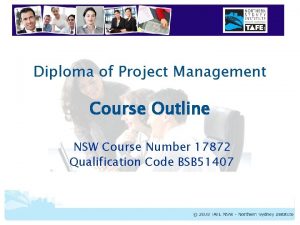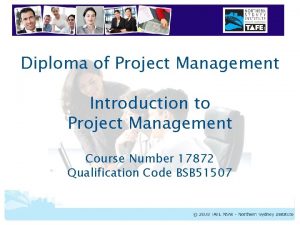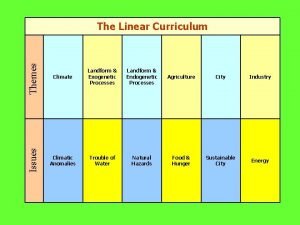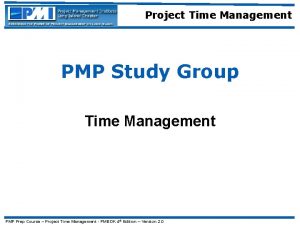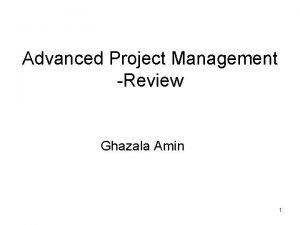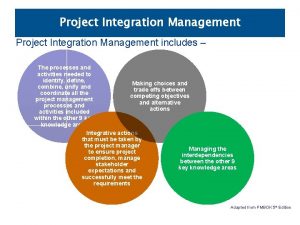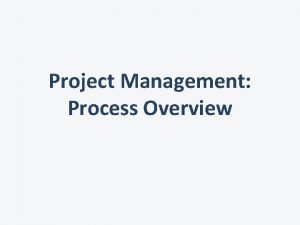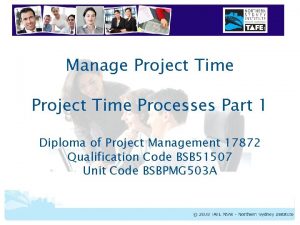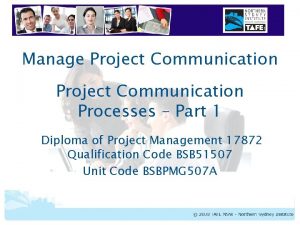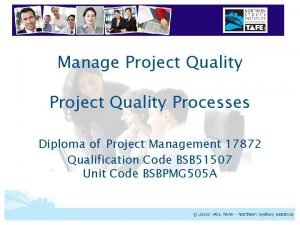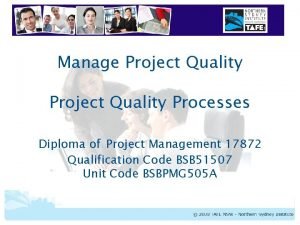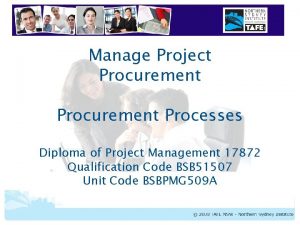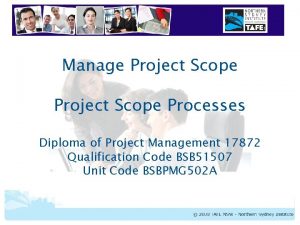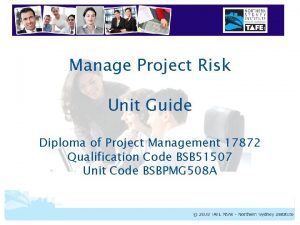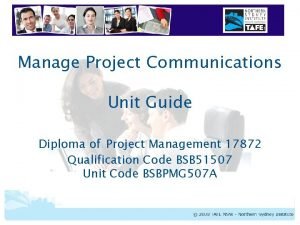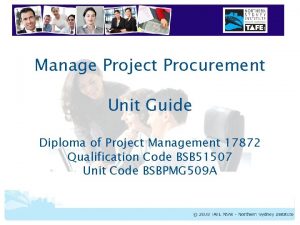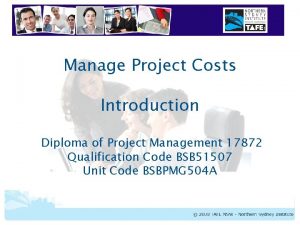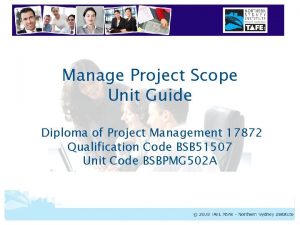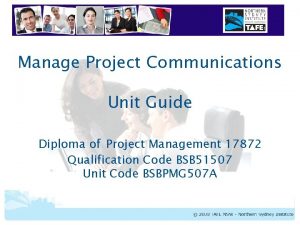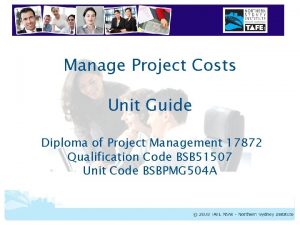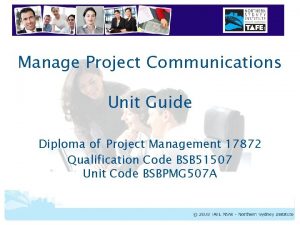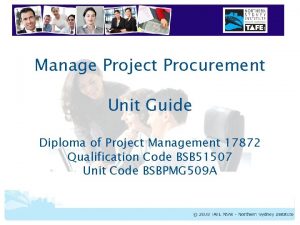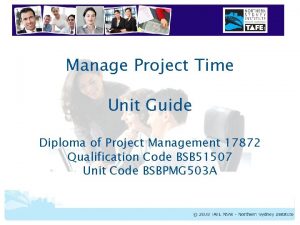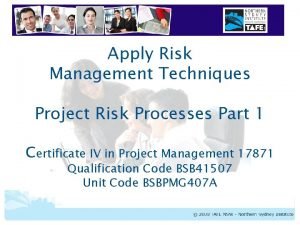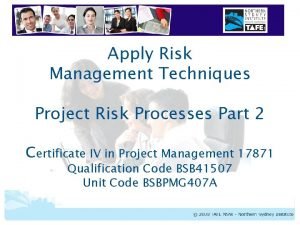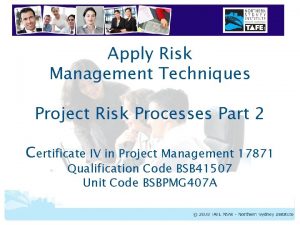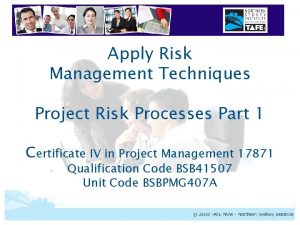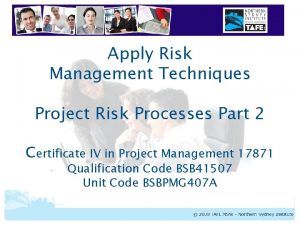Manage Project Risk Processes Part 1 Diploma of


























- Slides: 26

Manage Project Risk Processes Part 1 Diploma of Project Management 17872 Qualification Code BSB 51507 Unit Code BSBPMG 508 A Manage Project Risk

Project Risk Management Processes PMBOK Project Risk Management Processes 11. 1 Plan Risk Management 11. 2 Identify Risks 11. 3 Perform Qualitative Risk Analysis 11. 4 Perform Quantitative Risk Analysis 11. 5 Plan Risk Responses 11. 6 Monitor and Control Risks Related processes from Project Integration Management – PMBOK 4 th Edition BSBPMG 508 A Manage Project Risk

Learning Objectives 1. Be able to plan for risk events on projects 2. Understand risk management processes and how to develop risk management strategies 3. Understand how to identify and prioritise potential risks 4. Describe and use risk analysis and reporting tools 5. Understand qualitative and quantitative risk analysis 6. Understand the use of the Risk Register and how to manage and control high priority risks 7. Understand how to report on risk during a project 8. Understand how to assess risk management outcomes at the end of a project BSBPMG 508 A Manage Project Risk

Reading – Risk Processes Please take some time to review – • PMBOK Chapters 11. 1, 11. 2, 11. 3, 11. 4, 11. 5 and 11. 6 • NEW - Risk Management Standard – AS/NZS ISO 31000: 2009 • Risk Management Companion- HB 4360 This could take 60 to 90 minutes BSBPMG 508 A Manage Project Risk

4. 1 Develop Project Charter • The process of developing a document that formally defines and authorises a project by documenting the initial requirements that will satisfy the needs of the Project Sponsor and stakeholder • The high level Project Risks are identified an estimate is made of the overall risk of the project, this can be important to project prioritisation decisions Monitor Initiation Planning Execution Close Control Adapted from PMBOK 4 th Edition • he Project Charter establishes a BSBPMG 508 A Manage Project Risk

4. 1 Develop Project Charter • Inputs into the Project Charter • Business need or rationale • Product and project description • Strategic Plan • Business Case • Regulations and standards • Contractual requirements • Methodologies, policies and procedures Adapted from PMBOK 4 th Edition BSBPMG 508 A Manage Project Risk

4. 1 Develop Project Charter • Common contents of a Project Charter – • • Project purpose or justification Project objectives – should be measurable Project description High level requirements High level risks or overall risk analysis Preferred timeframe Estimated high level budget High level project structure – Project Sponsor, Project Manager • Authorisation or Governance processes PMBOK 4 th BSBPMG 508 A Manage Project Risk Edition

4. 2 Develop Project Management Plan • This is the process of defining and documenting the actions necessary to prepare and integrate all subsidiary plans for each of the 8 key knowledge areas of project management. • The planning processes for all project management key knowledge areas are normally performed at the same time and during this process, or expanded upon shortly afterwards. Monitor Initiation Planning Execution Close Control Adapted from PMBOK 4 th Edition BSBPMG 508 A Manage Project Risk

4. 2 Develop Project Management Plan • Typically, a detailed Risk Log will be developed during this process. • Very high priority risks may also have specific Risk Action Plans developed to ensure that they can be enacted quickly if the risk occurs. • Together with Scope Creep, risks and issues that occur on critical path activities cause the biggest delays and financial impacts to projects. Adapted from PMBOK 4 th Edition BSBPMG 508 A Manage Project Risk

11. 1 Plan Risk Management • The process of defining how to conduct risk management activities for a project • Detailed risk planning enhances the overall probability of successful project completion • Risk planning creates visibility of the degree and types of risk inherent in a specific project • For high risk, large and complex projects – contingency is often added to cover responses to unexpected risks Monitor Initiation Planning Execution Close Control Adapted from PMBOK 4 th Edition • The risk planning process (11. 1) happens BSBPMG 508 A Manage Project Risk

11. 1 Plan Risk Management • Inputs to Plan Risk Management • Project Scope Statement • Cost Management Plan • Schedule Management Plan • Communications Management Plan • Enterprise Environmental factors • Organisational Process Assets – Risk management standards – Risk management policies and procedures – Risk categories and definitions – Standard templates – Lessons learned from previous projects BSBPMG 508 A Manage Project Risk Initiation Monitor Planning Execution Close Control Adapted from PMBOK 4 th Edition

11. 1 Plan Risk Management • The PMBOK includes only one technique for this process – Planning Meetings and Analysis, this is a very simplistic view. • Other tools and techniques have been included here from practice - Risk Management Planning Standards Meetings Workshops Risk Management Methodologies Stakeholder Consultation Templates Standard Risk Categories Subject Matter Experts BSBPMG 508 A Manage Project Risk Analysis Tools Risk Registers

11. 1 Plan Risk Management • Outputs of this process include – • Risk Management Plan – Risk management methodology – Risk management roles and responsibilities – Risk Action plans including costs and resources required to manage specific risks – Risk categories – Risk probability and likelihood matrix – Risk Log • Project Document Updates Monitor Initiation – Stakeholder Register and Responsibility Assignment Matrices (part of Project HR) BSBPMG 508 A Manage Project Risk Planning Execution Close Control Adapted from PMBOK 4 th Edition

Risk Management Plan • The Risk Management Plan describes how risk management will be structured and performed on the project. It is a subset of the overall Project Management Plan. • Common inclusions in the Risk Management Plan – • Risk management methodology • Risk management roles and responsibilities Monitor Initiation Planning Execution • Risk Action plans including costs and resources required to manage specific risks Adapted from PMBOK 4 Close Control th • Risk categories BSBPMG 508 A Manage Project Risk Edition

Risk Categories • Risk categorisation is critical • It helps to ensure that all aspects of risk on the project are considered • Standard risk categories are hard to find • Start with the Project Management Key Knowledge Areas and industry frameworks • Risk Breakdown Structure – • Lists the categories and sub-categories within which risks may arise for a typical project • Different RBSs will be appropriate for different BSBPMG 508 A Manage Project Risk types of projects, different organisations and

Example Risk Breakdown Structure Project Management External Technical Organisational Estimating Subcontractors & Suppliers Requirements & Scope Dependencies Planning Regulatory Technology Human Resources Controlling Market/Economy Complexity Funding Communication External Customer Performance & Reliability Prioritisation Environment Quality PM Environment Adaptations and additions to the example in the PMBOK Methodology & Materials Adapted from PMBo. K Guide – Fourth Edition BSBPMG 508 A Manage Project Risk

11. 2 Identify Risks • The process of determining which risks may affect the project and documenting their characteristics • This is an interactive process as new risks may evolve or become known during the project • Participants in risk identification activities can include – Monitor Initiation – Project Manager and Project Team – Project Sponsor and Stakeholders BSBPMG 508 A Manage – Project Risk management experts Planning Execution Close Control Adapted from PMBOK 4 th Edition

11. 2 Identify Risks • Inputs to Identify Risk • Risk Management Plan • Activity Cost Estimates • Activity Duration estimates • Scope Baseline • Stakeholder Register • Cost Management Plan • Schedule Management Plan • Quality Management Plan Monitor Initiation Planning Execution Close Control Adapted from PMBOK 4 th Edition BSBPMG 508 A Manage Project Risk

11. 2 Identify Risks • Inputs to Identify Risk (continued) • Project Documents – – Assumptions Log – Work performance reports – Requirements • Enterprise Environmental Factors – – – Research and publications External Risk Management Standards Checklists and Benchmarks Industry studies Risk Attitudes • Organisational Process Assets – Project Files – Risk Management Templates BSBPMG 508 A Manage Risk Learning – Project Lessons Monitor Initiation Planning Execution Close Control Adapted from PMBOK 4 th Edition

11. 2 Identify Risks • Tools and techniques for identifying risk include Questionnaires Interviews and Documentation Reviews Brainstorming Workshops System or Process Assumptions Analysis Flowcharts Expert Judgement SWOT Analysis Industry Risk Frameworks Risk Checklists Influence Diagrams Lessons Learnt Surveys Root Cause Analysis Cause & Effect Diagrams Risk Categories Adapted from PMBOK 4 th Edition BSBPMG 508 A Manage Project Risk

11. 2 Identify Risks Risk Checklists & Questionnaires • Many organisations and certain industries have standard risk checklists and questionnaires that assist with the identification of the overall risk on a project, as well as the specific risks that may be applicable Assumptions Analysis • Any assumptions that have been documented during the planning processes need to be analysed and included in the Risk Log. Is any assumption does not prove to be true there will be impacts to project objectives, the risk of assumptions proving untrue must be evaluated. Risk Categories • Many organisations and certain industries have standard risk categories which help to ensure that all risk areas are reviewed when undertaking risk planning BSBPMG 508 A Manage Project Risk

11. 2 Identify Risks SWOT Analysis • Standard approach used to identify risks and opportunities during business planning and marketing activities. Can also be applied to project risk identification. Involves the identification of an organisations Strengths, Weaknesses, Opportunities and Threats. Weakness and Threats may need to documented in project risk logs. Expert Judgement • Many organisations will have specialised risk management teams that can provide expert assistance to projects in the planning and identification of risks. In very risky projects it may also be helpful to consult external subject matter experts. Industry Risk Frameworks • Some industries, particularly Construction and Defence, have standard risk frameworks which are extremely helpful to project risk management. BSBPMG 508 A Manage Project Risk

11. 2 Identify Risks • Outputs of this process include – • Initial entries on the Risk Register • List of identified risks • Potential risk owners • List of potential responses Risk ID Risk Category Risk Description Risk Owner Likelihood Impact Risk Rating Management /Mitigation Strategies Residual Likelihood Residual Impact Residual Rating Status Sample column headings in a typical Risk Register Priority Adapted from PMBOK 4 th Edition BSBPMG 508 A Manage Project Risk

Inclusions in Risk Register during Planning Risk ID Risk Category Risk Description Risk Owner Likelihood Impact Risk Rating Management /Mitigation Strategies Residual Likelihood Risk Id Risk Description • Can be a simple as a number • Plain English explanation of the risk • One to two sentences in length • Ensures common understanding • May relate to the risk category • Used as a unique identifier • may be an internal standard Residual Impact Residual Rating Status Risk Category Risk Owner • Can be taken from industry frameworks • Can be set at internal standards • May need to be developed/tailored • Ensures identification of all risks • Assists with monitoring and control • A specific person or role • Ensures clear ownership of the risk • Responsible for monitoring & control Priority Adapted from PMBOK 4 th Edition BSBPMG 508 A Manage Project Risk

Risk Planning and Identification 1. Take some time to locate the risk management polices and procedures of you organisation. 2. Take some time to review the Australian Risk Management Standards and companion handbook. 3. Are there specific standards, tools and templates that your organisation provides to assist project managers to plan for and identify risks? 4. Compare your organisation’s risk management policies to the suggestions in the standard. How can they be improved? 5. Then go to the Forum on Risk Planning and Identification answer the questions posed and discuss your findings with other students. Research BSBPMG 508 A Manage Project Risk Reflect Discuss

Next Steps Please proceed to Risk Processes Part 2 in the Learning Program. Best of Luck! BSBPMG 508 A Manage Project Risk
 Bsbpmg508a
Bsbpmg508a Market risk credit risk operational risk
Market risk credit risk operational risk Concurrent processes are processes that
Concurrent processes are processes that 111 project
111 project What is pre assignment in project management
What is pre assignment in project management Direct and manage project work
Direct and manage project work Direct and manage project work
Direct and manage project work Project costing diploma
Project costing diploma American diploma project
American diploma project Bsb51407
Bsb51407 Dual diploma project management
Dual diploma project management Wharton opim
Wharton opim Exogenetic processes part 2
Exogenetic processes part 2 Project time management definition
Project time management definition Project management processes
Project management processes Project integration management example
Project integration management example Six processes of project integration management
Six processes of project integration management The process consists of
The process consists of Draw rmmm plan
Draw rmmm plan Avoidance risk
Avoidance risk Relative risk calculation
Relative risk calculation Residual risk and secondary risk pmp
Residual risk and secondary risk pmp Ar = ir x cr x dr
Ar = ir x cr x dr Absolute risk vs relative risk
Absolute risk vs relative risk Smg stock split
Smg stock split Pestle risk classification system
Pestle risk classification system Pembiayaan risiko (risk financing)
Pembiayaan risiko (risk financing)
